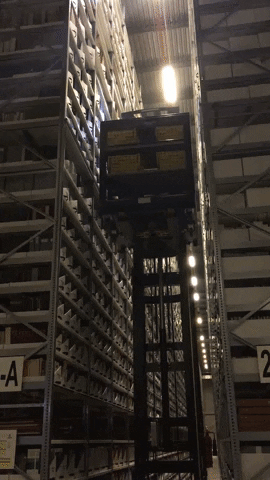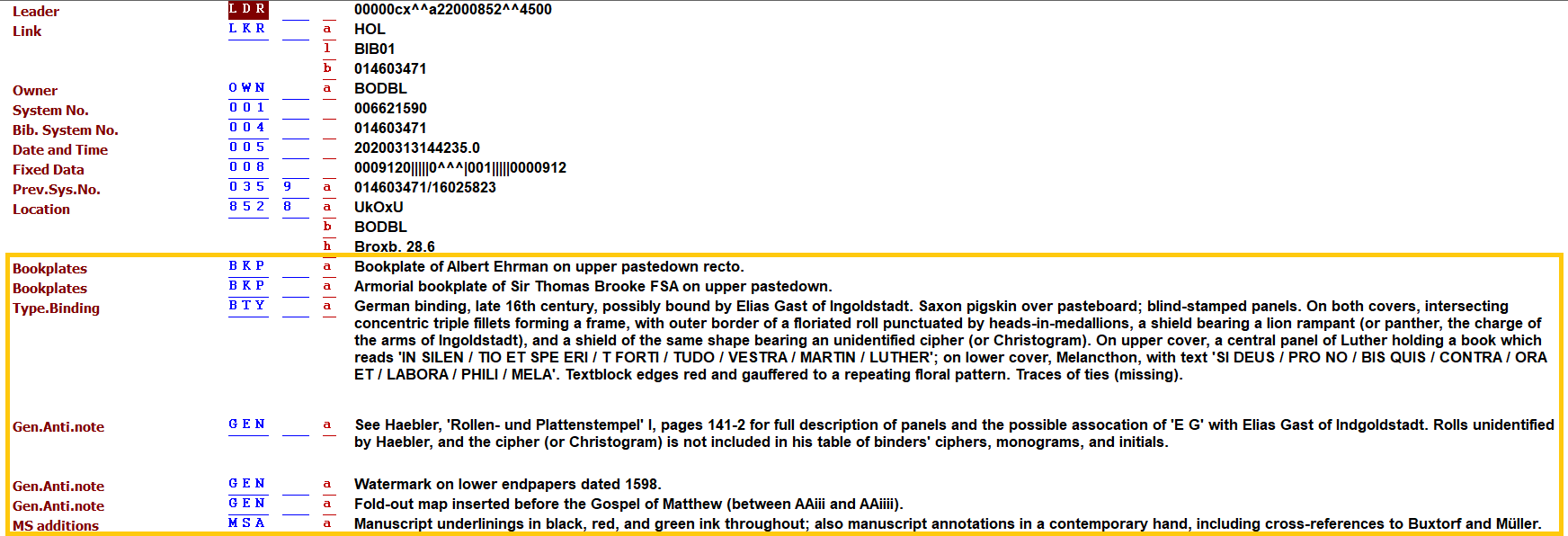Working from home for the foreseeable future, locked-down librarians are wistfully recalling the rustling of pages, the gentle bustle of readers, and that unmistakable eau de bibliothèque. Whilst the Bodleian is working hard at ‘keeping the University reading‘, and we’re all getting used to Teams and Zoom, a VPN’s no substitute for being among the books. So, while we’re all yearning for more library in our lives, what better time to revisit our 2019 trip to the Bodleian Storage Facility — which holds more books than anyone can imagine.

Some quick facts:
- The BSF opened in 2010, with an initial capacity of 8.4 million items
- It sits on a 17-acre site just outside of Swindon
- The BSF replaced the New Bodleian (now the Weston Library) as the main storage site
- Following reconfiguration, the BSF now holds over 12 million items
- A book delivery service to departmental libraries operates twice a day on weekdays
- In October 2015, the BSF fulfilled its one millionth book request
The Grand Tour
Our visit began with a talk by Boyd Rodger, the (then) Logistics Manager of the BSF. Boyd gave us a run-down of the BSF and the book delivery service. The BSF differs from a library in a few important ways. Items at the BSF are organised only by size, which should scandalise any librarian. You won’t find any readers here, either, and you can’t browse the BSF’s shelves in any conventional sense — but you can order any book from the BSF to arrive the following weekday, or that afternoon if you got your order in before 10am. Every item is barcoded, so requests placed via SOLO are logged by the BSF’s computer system, which tells staff where to find books and the optimal order in which to pick them. Once gathered, requests are boxed in the processing area and loaded onto vans for delivery. At their destination libraries, deliveries are scanned in and returns loaded back onto the van. Efficiency is key, because book delivery is a vital part of Reader Services at the Bodleian Library. Boyd told us that e-books aren’t threatening to close libraries — in fact, the Bodleian is buying more physical books than ever.

So how do you store 12.5 million books — and not only books, but maps, manuscripts, microfilms, periodicals and newspapers too? By 2009, the New Bodleian (which had 11 floors of space) as well as facilities at Nuneham Courtenay and a salt mine in Cheshire (yes, really) were at capacity. Costing approximately £25 million, and involving the biggest book-move in the Bodleian’s history (6.5 million items!), the BSF needed some serious storage. As we entered the main warehouse, it became clear that they really pulled it off.


The BSF is huge. Its shelves are 11 metres high and over 70 metres long. Before the automatic lights kick in, the narrow aisles seem to converge into darkness. We wore high-visibility jackets to alert staff driving the book-retrieval vehicles to our presence. A cross between a cherry-picker and a forklift, these vehicles are configured to fit exactly between the shelves, allowing staff to retrieve an impressive average of one book per minute. Although I personally wouldn’t like to be 11 metres up in the air, Boyd assured us it’s a very safe operation!
During downtime, staff at the BSF conduct stock-takes and look for ways to consolidate and optimise the available space. For us trainees, Boyd’s most important lesson was that future-ready libraries must be logistically and spatially adaptable:
- Low-use books kept in storage might suddenly become grow in demand and require relocation ‘on-site’, or vice-versa;
- Renovation or building work might require temporary storage (in fact, the BSF currently holds several thousand volumes from Cambridge), so could your facility accommodate for that?
- Existing space can always be reconfigured to meet new challenges and needs;
- Since an off-site facility means books always moving around, could it also offer research facilities? Some libraries are considering specialised reading rooms to avoid transit for fragile or valuable material.
Perhaps most importantly, as the current crisis forces libraries everywhere to re-imagine services, the BSF’s dual role in storage and logistics brings it to the fore of the Bodleian Libraries’ updated Scan & Deliver service. Pre-lockdown, photocopies of material in storage were useful for scholars who could not visit a library; in our cautious post-lockdown world, it’s clear that the ability to provide resources remotely will be vital.
All of this is a far cry from what the librarians of yore imagined. As a trainee at the Weston Library, I was aware of the building’s history as the old stack, and of the early-century conveyor belt that famously transported books underneath Broad Street to the Old Bodleian. I wondered how books were kept before it was built, and the archives obliged…

A Brief History of Space
In 1908, the incumbent Bodley’s Librarian, E. W. B. Nicholson, made a public plea to save the Proscholium from a grim fate as a glorified bike shed. The idea is barely conceivable to us now: the Proscholium, refurbished in 2009, has become a central hub for students and tourists alike. But in Nicholson’s day the Library was short on space, and every available nook was in danger of being turned into storage. The acquisition of the entire Old Bodleian quadrangle by 1859 (which had, according to Thomas Bodley’s vision, housed examination and teaching rooms) and the Radcliffe Camera in 1860 couldn’t match the rapid growth of the collections. In 1909, work began on the Underground Bookstore beneath the Radcliffe Camera (which now houses the Gladstone Link), the Library’s first purpose-built storage solution. At the time, it was the largest bookstore of its kind in the world. The Oxford Chronicle for 29th November 1912 recorded the opening speech of Nicholson’s successor, Falconer Madan, who even at that moment was conceptualising more storage:
‘Then will be the time for the engineers to set to work burrowing on the other side of the Camera, so that another quarter of a century’s growth may be provided for by a second subterranean chamber’.
The prophetic Madan foresaw that ‘within fifty years every college and institution will have a receptacle for its stores beneath its front quadrangle’ — in recent years, St John’s, Magdalen, and the Queen’s College have all completed very similar projects. What’s also interesting about Madan’s speech is the admission that even the Bookstore represented borrowed time. Sure enough, within that quarter of a century, designs were drawn up for another new storage facility that would provide some respite for the Bodleian’s beleaguered librarians and cataloguers. Giles Gilbert Scott’s design for the New Bodleian won him the contract, but here are a few proposals from the archives that didn’t make the cut:

One particularly dreadful design would have seen the Old Bodleian’s Quadrangle roofed over and the resulting central compartment turned into stacks. Although in concept this isn’t too far removed from the New Bodleian, I’m sure we’re all glad it was rejected…!
In 1602, Thomas Bodley could not ‘rest as yet satisfied’ with the small number of books in his new Library, but predicted correctly that an influx of donations could only influence more. Centuries on, and the Bodleian has benefited from enormous donations, greatly increased buying power, and the strengthening of its historical legal deposit. It’s anticipated that the Bodleian Storage Facility will get an extension within the near future, as more and more items pour in. A modern history of the Bodleian, then, is one of exponential growth — 220,000 printed books in 1849; one million books in 1914; some 12 million today — and a far cry from the modest 2,500 tomes that once comprised Duke Humfrey’s Library.







Recent Comments